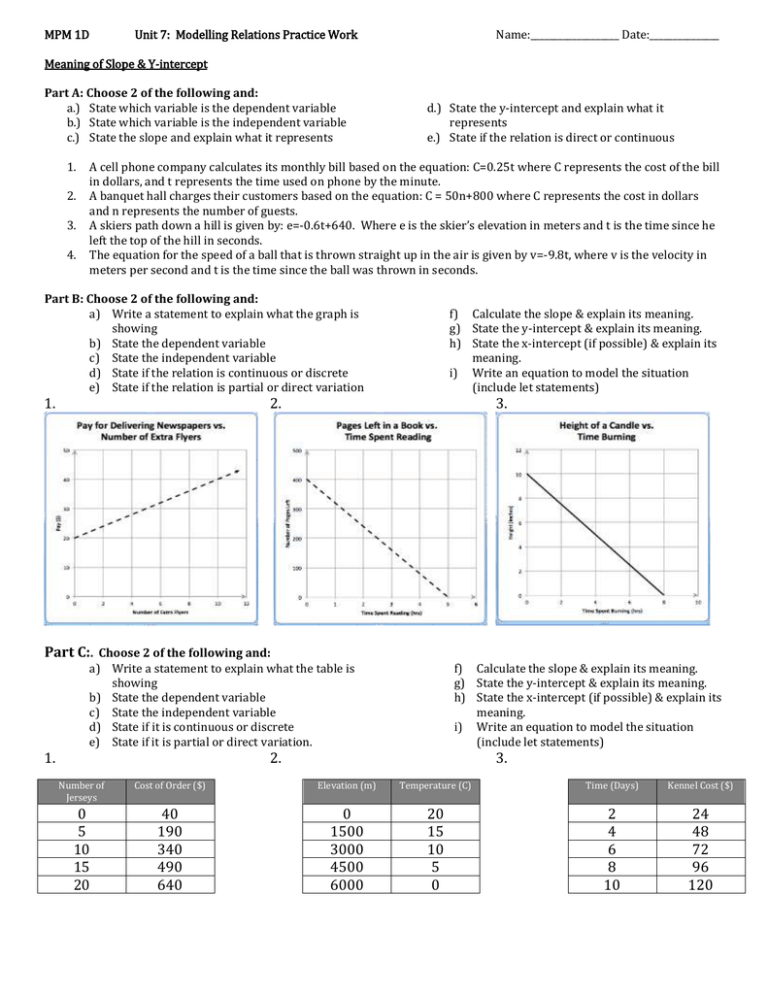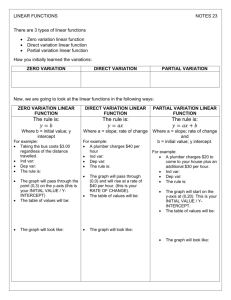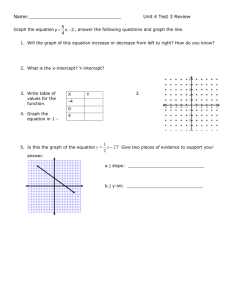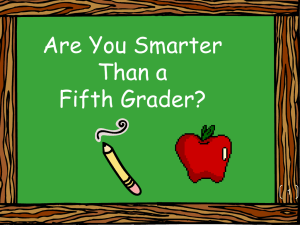handout
advertisement

MPM 1D Unit 7: Modelling Relations Practice Work Name:___________________ Date:_______________ Meaning of Slope & Y-intercept Part A: Choose 2 of the following and: a.) State which variable is the dependent variable b.) State which variable is the independent variable c.) State the slope and explain what it represents 1. 2. 3. 4. d.) State the y-intercept and explain what it represents e.) State if the relation is direct or continuous A cell phone company calculates its monthly bill based on the equation: C=0.25t where C represents the cost of the bill in dollars, and t represents the time used on phone by the minute. A banquet hall charges their customers based on the equation: C = 50n+800 where C represents the cost in dollars and n represents the number of guests. A skiers path down a hill is given by: e=-0.6t+640. Where e is the skier’s elevation in meters and t is the time since he left the top of the hill in seconds. The equation for the speed of a ball that is thrown straight up in the air is given by v=-9.8t, where v is the velocity in meters per second and t is the time since the ball was thrown in seconds. Part B: Choose 2 of the following and: a) Write a statement to explain what the graph is showing b) State the dependent variable c) State the independent variable d) State if the relation is continuous or discrete e) State if the relation is partial or direct variation 1. f) Calculate the slope & explain its meaning. g) State the y-intercept & explain its meaning. h) State the x-intercept (if possible) & explain its meaning. i) Write an equation to model the situation (include let statements) 2. 3. Part C:. Choose 2 of the following and: a) Write a statement to explain what the table is showing b) State the dependent variable c) State the independent variable d) State if it is continuous or discrete e) State if it is partial or direct variation. 1. f) Calculate the slope & explain its meaning. g) State the y-intercept & explain its meaning. h) State the x-intercept (if possible) & explain its meaning. i) Write an equation to model the situation (include let statements) 2. 3. Number of Jerseys Cost of Order ($) Elevation (m) Temperature (C) Time (Days) Kennel Cost ($) 0 5 10 15 20 40 190 340 490 640 0 1500 3000 4500 6000 20 15 10 5 0 2 4 6 8 10 24 48 72 96 120 Standard Form: 1. Nimitha buys fruit at her local farmer’s market. This Saturday, oranges cost $2 per pound and cherries cost $3 per pound. She has $12 to spend on fruit. a. Define the two variables in this situation. b. Write a word equation to model this situation c. Write an algebraic equation to model this situation. d. If she buys 3 pounds of oranges, how many pounds of cherries can she buy? 2. You are in charge of buying the hamburger and chicken breasts for a barbecue. The hamburger costs $2 per kilogram and the chicken costs $4.50 per kilogram. You have $30 to spend. a. Define the two variables in this situation b. Write a word equation to model this situation c. Write an algebraic equation to model this situation d. Calculate the intercepts and state what each represents e. Graph the relation. 3. An online store sells songs for $1.25 each and games for $2 each. Scott received a $30 gift card to the store for his birthday. a. Define the two variables in this situation. b. Write a word equation to model this situation. c. Write an algebraic equation to model this situation. d. Calculate the intercepts and state what each represents. e. Graph the relation. 4. Leanne works at greenhouse. She needs to plant a total of 32 bulbs including some crocus bulbs and some tulip bulbs. a. What are the two variables in this situation b. Write a word equation to represent the number of bulbs total. c. Write an algebraic equation to represent the number of bulbs total. d. Graph this equation. e. She is asked to plant three times as many crocus bulbs as tulip bulbs. Write an equation to represent this relation. f. Graph this relation on the same grid as (d). g. What does the point of intersection represent? Changing the Situation: 1. Steve is renting a Moped for the day. a. It costs him $35 initial fee plus $2 for every litre of fuel used. i. What are the two variables in this situation? ii. Create an algebraic equation including let statements to model this situation. iii. Create a graph that shows total cost for up to 15 litres of fuel used. iv. Label the line with the algebraic equation that you have created. b. They change their fees to $28 initial fee plus $2 for every litre of fuel used. i. Create an algebraic equation to model this situation use the same variables as in the first situation. ii. Graph a line to represent this new situation on the same grid iii. Label the line with the algebraic equation that you have created. c. Discuss the changes. i. What was changed in this situation (the rate of change or the starting value) ii. How was this evident in the equation? iii. How was this evident in the graph? 2. Jocelyn has a full time job selling newspaper ads. a. She makes $32 a day plus $ 8 for each ad she sells. i. What are the two variables in this situation? ii. Create an algebraic equation to model this situation including let statements. iii. Use these values to create a graph of that shows total cost up to 15 ads. iv. Label the line with the algebraic equation that you have created. b. Jocelyn’s rate changes to $32 a day plus $10 per ad. i. Create an algebraic equation use the same variables as in the first situation. ii. Graph a line to represent this new situation on the same grid iii. Label the line with the algebraic equation that you have created. c. Discuss the changes. i. What was changed in this situation (the rate of change or the starting value) ii. How was this evident in the equation? iii. How was this evident in the graph? 3. 4. Sally runs a child care business. She charges $50 a day plus $15 for each child she watches. a. Define the two variables in this situation. b. Create an equation to represent this situation. c. She wants to increase her income. Suggest a new pay structure with a higher base fee. d. Write a new equation for this situation. e. If you were to draw both of these pay structures on the same grid what would be the similarities and differences in the two relations? The graph below is for the cost of a cell phone plan. a. Calculate the slope and explain what it represents. b. Identify the y-intercept and explain what it represents. c. Write an equation to model this cost structure (include let statements) d. The cell phone company has decided they need to increase their pay structure to bring in more money. They would like to increase their cost per minute. Sketch what this change would look like on the graph and write a possible new equation for this situation. REVIEW: 1. A seedling was 4 cm tall when planted. After 2 months it was 12 cm tall. Find the average rate of change per month. Write an equation for the height of the plant in terms of time (in months). 2. Kim Li’s cell phone bill was $71.50 dollars in October when she used 105 long distance minutes. Her bill in November was $58 when she used only 60 long distance minutes. How much does it cost per long distance minute used. How much is the base monthly fee? Write an equation for the monthly cost of her cell phone bill in terms of minutes used. ANSWERS: Meaning of Slope & Y-intercept Part A 1. Dep. Var: Monthly Cost ($) Indep. Var: time used (minutes) Slope: 0.25 ($0.25/min.) y-int: 0 (no base fee) Discrete relation, with direct variation 2. Dep. Var: Monthly Cost ($) Indep. Var: # of people attending Slope: 50 ($50/per.) y-int: 800 (base fee) Discrete relation, with partial variation 3. Dep. Var: elevation (m) Indep. Var: time (seconds) Slope: -0.6 (down 0.6m/s) y-int: 640 (initial elev) Continuous relation, with partial variation 4. Dep. Var: Velocity (m/s) Indep. Var: time (seconds) Slope: -9.8 (deceler 9.8m/s) y-int: 0 (no initial height) Continuous relation, with direct variation Part B 1. a) The amount of pay received to deliver newspapers based on # of flyers in paper b) Dep. Var: Pay ($) c) Indep. Var: # of flyers d) & e) Discrete relation, with partial variation f) Slope: 2 ($2/flyer) g) y-int: 20 (base fee) h) x-int : none i) Let p represent pay ($). Let f represent the # of extra flyers purchased p = 2f + 20 2. a) The time spent reading vs. the nuber of pages left in a book b) Dep. Var: # of pages left c) Indep. Var: time (hr.) d) & e) Discrete relation, with partial variation f) Slope: -80 (80 pgs. less/hr) g) y-int: 400 (# of pgs. in book) h) x-int : 5 (# of hrs to read whole book) i) Let p represent # of pages left. Let t represent time reading (hr.) p = -80t + 400 3. a) The height of a candle and the length of time it has been burning. b) Dep. Var: height of candle (in.) c) Indep. Var: time (hr.) d) & e) Continuous relation, with partial variation f) Slope: -1.25 (1.25 in. lower/hr) g) y-int: 10 (initial height) h) x-int : 8 (# of hrs to burn whole candle) i) Let h represent the height of candle (inches). Let t represent time (hr.) p = -1.25t + 10 Part C 1. a) Cost to print jerseys vs. # of jerseys. As order increases in # so does the cost. b) Dep. Var: Total Cost($) c) Indep. Var: # of jerseys d) & e) Discrete relation, with partial variation f) Slope: 30 ($30/jersey) g) y-int: 40 (base fee) h) x-int : none i) Let c represent total cost ($). Let j represent the # of jerseys ordered c = 30j + 40 2. a) Elevation (m) vs. Temperature (°C). As elevation increases the temperature decreases. b) Dep. Var: Temperature (°C) c) Indep. Var: Elevation (m) d) & e) Continuous relation, with partial variation f) Slope: -1/300 (1°C drop/300m) g) y-int: 20 (at height of 0m the temp is 20°C) h) x-int : 6000 (at height of 6000m the temp is 0°C) i) Let e represent elevation(m). Let T represent temperature(°C) T = -1/300e + 20 3. a) Cost of Kennel($) vs. Length of Stay (days). As stay increases so does the cost. b) Dep. Var: Cost of Kennel($) c) Indep. Var: Length of Stay (days) d) & e) Discrete relation, with direct variation f) Slope: 12 ($12/day) g) y-int: 0 (no base fee) h) x-int : 0 (no cost for zero days) i) Let c represent total cost ($). Let t represent the time (days) c = 12t Standard Form 1. a) Let g represent the weight of oranges purchased (lbs.). Let c represent the weight of cherries purchased (lbs.) b) Total Cost = unit price of oranges x weight of oranges + unit price of cherries x weight of cherries c) 12 = 2g + 3c d) 2 lbs. of cherries 2. a) Let h represent the weight of hamburger purchased (kg). Let c represent the weight of chicken purchased (kg). b) Total Cost = unit price of hamb x weight of hamb + unit price of chicken x weight of chicken c) 30 = 2h + 4.50c d) Amount of hamburger if no chicken, Amount of chicken if no hamburger 3. a) Let g represent the # of games purchased. Let m represent the # of songs purchased. b) Total Cost = unit price of games x # of games + unit price of songs x # of songs c) 30 = 1.25g + 2m d) Amount of games if no songs, Amount of songs if no games 4. a) Let c represent the # of crocus bulbs. Let t represent the # of tulip bulbs. b) Total # of Bulbs = # of crocus bulbs + # of tulip bulbs c) 32 = c + t e) c = 8t g) (8, 24) 8 tulip bulbs, 24 crocus bulbs Changing the Situation 1. a) i)Total Cost ($) and Volume of Fuel (L) ii) Let c represent total cost ($). Let v represent volume of fuel (L) C = 2v+35 b) i) C = 2v+28 c) i)The rate of change is the same but the rental cost has decreased. ii) y-int decreased. iii) Graph down 7 Review 1. 2. 4cm/month; Equation: H = 4n + 4 $0.30/min; base fee $40 Equation: C = 0.30n + 40




